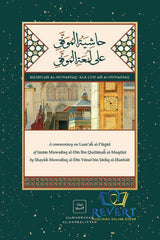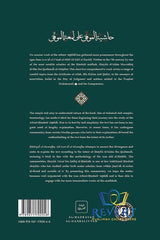



The Matn is Bilingual and the Commentary is in English in the Classic Hashiyah style.
No concise work of the Athari ‘aqidah has gathered more prominence throughout the ages than Lum’ah al -l’tiqab al- Hadi ila Sabil al- Rashid. Written in the 7th century by one of most notable scholars of the Ḥanbali madhab, Shaykh al-Islām al-Muwaffaq b. Qudāmaḧ al-Maqdisī. This short but comprehensive work covers a range of creedal topics from the Attributes of Allāh, His Kalam, and Qadar, to the concepts of innovation, belief in the Day of Judgment and matters related to the Prophet Muhammad ﷺ and his Companions.
The simple and easy to understand nature of the book, free of technical and complex terminology, has made it ideal for those beginning their journey into the study of the Atharī-Ḥanbali ‘aqidaḧ. Due to its brevity and simplicity, the text has not been in any great need of lengthy explanations. However, in recent times, it has undergone commentary from certain Muslim groups who have, in their explanations, diverted the understanding of the text from the intention of its author. Ḥashiyah al-Muwaffaq ‘ala Lum’ah al-Muwaffaq attempts to correct this divergence from the Atharī-Ḥanbalī ‘aqīdaḧ and seeks to explain the text according to the intent of Shaykh al-Islām b. Qudāmaḧ, restoring it back in line with the methodology of the true Ahl al-Ḥadīth.
It is important to note that the Hanbali Aqidah, which has historically been called the Athari Aqidah, is not synonymous with the contemporary Salafi Aqidah which is often erroneously labelled as such, has a distinct approach when it comes to the attributes of Allah. Additionally, they too disagree with the position of the Hanabilah on other points of Aqidah. However, as stated previously, expounding these differences is not the focus of this work.
About The commentator
The commentator, Shaykh Yūsuf b. Ṣadiq al-Ḥanbali, is one of few traditional Ḥanbali shaykhs, who studied under senior scholars from both within Jāmi’aḧ al-Azhar al-Sharīf and outside of it. By presenting this commentary, we hope the reader becomes well acquainted with the true Atharī-Ḥanbalī ‘aqīdaḧ and is then able to engage with the more intermediate works of this madhhab.
Some of the scholars The Commentator studied under
Shaykh Yusuf b. Ṣādiq studied under scholars from both al-Azhar University (Jami‘aḧ al-Azhar al-Sharif) and scholars outside of it; from Egypt as well as other countries. The most important of the scholars he studies under is the Grand Shaykh of the Ḥanabilah, Shaykh Dr. Muḥammad Sayyid al-Ḥanbali, the main teacher of the Ḥanbali madhhab in Jami‘ al-Azhar al-Sharif. Shaykh yusuf also studied under Shaykh Aḥmad Ma‘bad ‘Abd al-Karim, Shaykh Aḥmad ‘Umar Hashim, and Shaykh Ḥasan al-Shafi‘i; all three being from the Higher Committee of scholars of al-Azhar al-Sharif. He also studied under Shaykh Ashraf Makkawi, Shaykh Ḥazim al-Kilani and Shaykh Jamal Faruq al-Daqaq, Shaykh ‘Ali Ṣaliḥ al-Azhari, Shaykh Rabi‘ al-Ghafir, Shaykh Fatḥi Ḥijazi, Shaykh Muḥammad Ḥasan ‘Uthman, and Shaykh Sa‘d Sa‘d Jawish. From outside of Egypt, Shaykh Yusuf studied with the Pakistan based muḥaddith Shaykh Muḥammad b. ‘Abd Allah al-Shuja' Abadi.
The Matn is Bilingual and the Commentary is in English in the Classic Hashiyah style.
No concise work of the Athari ‘aqidah has gathered more prominence throughout the ages than Lum’ah al -l’tiqab al- Hadi ila Sabil al- Rashid. Written in the 7th century by one of most notable scholars of the Ḥanbali madhab, Shaykh al-Islām al-Muwaffaq b. Qudāmaḧ al-Maqdisī. This short but comprehensive work covers a range of creedal topics from the Attributes of Allāh, His Kalam, and Qadar, to the concepts of innovation, belief in the Day of Judgment and matters related to the Prophet Muhammad ﷺ and his Companions.
The simple and easy to understand nature of the book, free of technical and complex terminology, has made it ideal for those beginning their journey into the study of the Atharī-Ḥanbali ‘aqidaḧ. Due to its brevity and simplicity, the text has not been in any great need of lengthy explanations. However, in recent times, it has undergone commentary from certain Muslim groups who have, in their explanations, diverted the understanding of the text from the intention of its author. Ḥashiyah al-Muwaffaq ‘ala Lum’ah al-Muwaffaq attempts to correct this divergence from the Atharī-Ḥanbalī ‘aqīdaḧ and seeks to explain the text according to the intent of Shaykh al-Islām b. Qudāmaḧ, restoring it back in line with the methodology of the true Ahl al-Ḥadīth.
It is important to note that the Hanbali Aqidah, which has historically been called the Athari Aqidah, is not synonymous with the contemporary Salafi Aqidah which is often erroneously labelled as such, has a distinct approach when it comes to the attributes of Allah. Additionally, they too disagree with the position of the Hanabilah on other points of Aqidah. However, as stated previously, expounding these differences is not the focus of this work.
About The commentator
The commentator, Shaykh Yūsuf b. Ṣadiq al-Ḥanbali, is one of few traditional Ḥanbali shaykhs, who studied under senior scholars from both within Jāmi’aḧ al-Azhar al-Sharīf and outside of it. By presenting this commentary, we hope the reader becomes well acquainted with the true Atharī-Ḥanbalī ‘aqīdaḧ and is then able to engage with the more intermediate works of this madhhab.
Some of the scholars The Commentator studied under
Shaykh Yusuf b. Ṣādiq studied under scholars from both al-Azhar University (Jami‘aḧ al-Azhar al-Sharif) and scholars outside of it; from Egypt as well as other countries. The most important of the scholars he studies under is the Grand Shaykh of the Ḥanabilah, Shaykh Dr. Muḥammad Sayyid al-Ḥanbali, the main teacher of the Ḥanbali madhhab in Jami‘ al-Azhar al-Sharif. Shaykh yusuf also studied under Shaykh Aḥmad Ma‘bad ‘Abd al-Karim, Shaykh Aḥmad ‘Umar Hashim, and Shaykh Ḥasan al-Shafi‘i; all three being from the Higher Committee of scholars of al-Azhar al-Sharif. He also studied under Shaykh Ashraf Makkawi, Shaykh Ḥazim al-Kilani and Shaykh Jamal Faruq al-Daqaq, Shaykh ‘Ali Ṣaliḥ al-Azhari, Shaykh Rabi‘ al-Ghafir, Shaykh Fatḥi Ḥijazi, Shaykh Muḥammad Ḥasan ‘Uthman, and Shaykh Sa‘d Sa‘d Jawish. From outside of Egypt, Shaykh Yusuf studied with the Pakistan based muḥaddith Shaykh Muḥammad b. ‘Abd Allah al-Shuja' Abadi.
Read more







